Salvator Rosa
Salvator Rosa (June 20 or July 21, 1615 – March 15, 1673) was an Italian Baroque painter, poet, and printmaker, who was active in Naples, Rome, and Florence. As a painter, he has been described as "unorthodox and extravagant" as well as being a "perpetual rebel"[1] and a proto-Romantic.
Salvator Rosa | |
|---|---|
 Salvator Rosa, Philosophy, a self-portrait c.1645. The Latin inscription is "Keep silent or say something better than silence". National Gallery, London | |
| Born | June 20 or July 21, 1615 |
| Died | March 15, 1673 (aged 57) |
| Nationality | Italian |
| Known for | Painting, printmaking, poetry |
| Movement | Baroque |
Early life
Rosa was born in Arenella, at that time in the outskirts of Naples, on either June 20 or July 21, 1615. His mother was Giulia Greca Rosa, a member of one of the Greek families of Sicily. His father, Vito Antonio de Rosa, a land surveyor, urged his son to become a lawyer or a priest, and entered him into the convent of the Somaschi Fathers. Yet Salvator showed a preference for the arts and secretly worked with his maternal uncle Paolo Greco to learn about painting. He soon transferred himself to the tutelage of his brother-in-law Francesco Fracanzano, a pupil of Ribera, and afterward to either Aniello Falcone,[1] a contemporary of Domenico Gargiulo,[2] or to Ribera. Some sources claim he spent time living with roving bandits.[3] At the age of seventeen, his father died; his mother was destitute with at least five children and Salvator found himself without financial support and the head of a household looking to him for support.
Life
_-_Allegory_of_Fortune_-_Google_Art_Project.jpg)
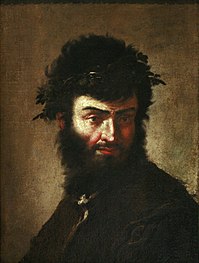
He continued apprenticeship with Falcone, helping him complete his battlepiece canvases. In that studio, it is said that Lanfranco took notice of his work, and advised him to relocate to Rome, where he stayed from 1634 until 1636.
Returning to Naples, he began painting haunting landscapes, overgrown with vegetation, or jagged beaches, mountains, and caves. Rosa was among the first to paint "romantic" landscapes, with a special turn for scenes of picturesque, often turbulent and rugged scenes peopled with shepherds, brigands, seamen, soldiers. These early landscapes were sold cheaply through private dealers.
He returned to Rome in 1638–39, where he was housed by Cardinal Francesco Maria Brancaccio, bishop of Viterbo. For the Chiesa Santa Maria della Morte in Viterbo, Rosa painted his first and one of his few altarpieces, the Incredulity of Thomas.
While Rosa had a facile genius at painting, he pursued a wide variety of arts: music, poetry, writing, etching, and acting. In Rome, he befriended Pietro Testa and Claude Lorrain. During a Roman carnival play he wrote and acted in a masque, in which his character bustled about Rome distributing satirical prescriptions for diseases of the body and more particularly, of the mind. In costume, he inveighed against the farcical comedies acted in the Trastevere under the direction of Bernini.
While his plays were successful, this activity also gained him powerful enemies among patrons and artists, including Bernini himself, in Rome. Around 1640, he accepted an invitation from Giovanni Carlo de' Medici to relocate to Florence, where he stayed until 1649.[4] Once there, Rosa sponsored a combination of studio and salon of poets, playwrights, and painters—the so-called Accademia dei Percossi (Academy of the Stricken). To the rigid art milieu of Florence, he introduced his canvases of wild landscapes; while influential, he gathered few true pupils. Another painter poet, Lorenzo Lippi, shared with Rosa the hospitality of the cardinal and the same circle of friends. Lippi encouraged him to proceed with the poem Il Malmantile Racquistato. He was well acquainted also with Ugo and Giulio Maffei, and was housed with them in Volterra, where he wrote four satires Music, Poetry, Painting, and War. About the same time he painted his own portrait, now in the National Gallery, London.
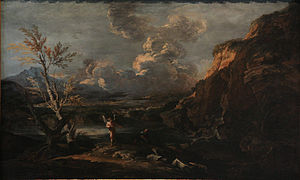
A passage in one of his satires suggests that he sympathized with the 1647 insurrection led by Masaniello—whose portrait he painted, though probably not from life. Rosa's tempestuous art and reputation as a rebel gave rise to a popular legend—recounted in a biography of Rosa published in 1824 by Sydney, Lady Morgan—that Rosa lived with a gang of bandits and participated in the uprising in Naples against Spanish rule.[4] Although these activities cannot be conveniently dovetailed into known dates of his career, in 1846 a famous romantic ballet about this story titled Catarina was produced in London by the choreographer Jules Perrot and composer Cesare Pugni).
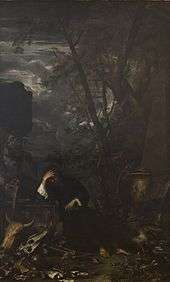
He returned to stay in Rome in 1649. Here he increasingly focused on large scale paintings, tackling themes and stories unusual for seventeenth-century painters. These included Democritus amid the Tombs, The Death of Socrates, Regulus in the Spiked Cask (these two are now in England), Justice Quitting the Earth and the Allegory of Fortune. This last work raised a storm of controversy among religious and civil authorities who perceived in it a satire directed at them. Rosa, endeavouring at conciliation, published a text in which he provided anodyne explanations for the painting's imagery; nonetheless he was nearly arrested.[5] It was about this time that Rosa wrote his satire named Babylon.
His criticisms of Roman art culture won him several enemies. An allegation arose that his published satires were not his own, but Rosa vehemently denied the charges. It may be possible that literary friends in Florence and Volterra coached him about the topic of his satires, while the compositions of which remained nonetheless his own. To confute his detractors he wrote the last of the series, entitled Envy.
Among the pictures of his last years were the Saul and the Witch of Endor and Battlepiece now in the Musée du Louvre, the latter painted in 40 days, full of longdrawn carnage, with ships burning in the offing; Polycrates and the Fishermen; and the Oath of Catiline (Palazzo Pitti).
While occupied with a series of satirical portraits, to be closed by one of himself, Rosa was assailed by dropsy. He died a half year later. In his last moments he married a Florentine named Lucrezia, who had borne him two sons, one of them surviving him. His tomb is in Santa Maria degli Angeli e dei Martiri, where a portrait of him has been set up. Salvator Rosa, after struggles of his early youth, had successfully earned a handsome fortune.
He was a significant etcher, with a highly popular and influential series of small prints of soldiers, and a number of larger and very ambitious subjects.
Among his pupils were Evangelista Martinotti of Monferrato and his brother Francesco. Another pupil was Ascanio della Penna of Perugia.[6]
Legacy
_1615%E2%80%931673_Rome).jpg)
During Rosa's lifetime his work inspired followers such as Giovanni Ghisolfi, but his most lasting influence was on the later development of romantic and picturesque traditions within painting.[4] Eighteenth-century artists influenced by Rosa include Alessandro Magnasco, Andrea Locatelli, Giovanni Paolo Panini and Marco Ricci.[4] As Wittkower states, it is in his landscapes, not his grand historical or religious dramas, that Rosa truly expresses his innovative abilities most graphically. Rosa himself may have dismissed them as frivolous capricci in comparison to his other themes, but these academically conventional canvases often restrained his rebellious streak. In general, in landscapes he avoided the idyllic and pastoral calm countrysides of Claude Lorrain and Paul Bril, and created brooding, melancholic fantasies, awash in ruins and brigands. By the eighteenth century, the contrasts between Rosa and artists such as Claude was much remarked upon. A 1748 poem by James Thompson, "The Castle of Indolence", illustrated this: "Whate'er Lorraine light touched with softening hue/ Or savage Rosa dashed, or learned Poussin drew".[7]
In a time when artists were often highly constrained by patrons, Rosa had a plucky streak of independence, which celebrated the special role of the artist. "Our wealth must consist in things of the spirit, and in contenting ourselves with sipping, while others gorge themselves in prosperity". He refused to paint on commission or to agree on a price beforehand, and he chose his own subjects. In his own words, he painted "...purely for my own satisfaction. I need to be transported by enthusiasm and I can only employ my brushes when I am in ecstasy."[8] This tempestuous spirit became the darling of British Romantics such as Henry Fuseli, John Hamilton Mortimer, and Alexander Runciman.[4] A recent exhibit of Turner's work, at the Prado museum in Madrid, notes the influence Rosa had on Turner, in his landscapes. An exhibition of Rosa's work held at London's Dulwich Picture Gallery in 2010 emphasised the strangeness of Rosa's painting and themes, showing his enthusiasm for "bandits, wilderness and magic".[9]
Rosa's reputation and influence waned in the nineteenth century; when his Monks Fishing was displayed in Dulwich in 1843 it was criticized by John Ruskin as telling "unmitigated falsehoods" and containing "laws of nature set at open defiance".[10] Since the 1960s, Rosa's work has received renewed attention from scholars.[4]
Satires

Cesareo (1892) and Cartelli (1899) wrote books taking account of Rosa's satires. The satires, though considerably spread abroad during his lifetime, were not published until 1719. They are all in terza rima, written without much literary correctness, but spirited. Rosa here appears as a very severe castigator of all ranks and conditions of men, not sparing the highest, and as a champion of the poor and down-trodden, and of moral virtue and Catholic faith.
The satire on Music exposes the insolence and profligacy of musicians, and the shame of courts and churches in encouraging them. Poetry dwells on the pedantry, imitativeness, adulation, affectation and indecency of poets—also their poverty, and the neglect with which they were treated; and there is a very vigorous sortie against oppressive governors and aristocrats. Tasso's glory is upheld; Dante is spoken of as obsolete, and Ariosto as corrupting.
Painting inveighs against the pictorial treatment of squalid subjects, such as beggars, against the ignorance and lewdness of painters, and their tricks of trade, and the gross indecorum of painting sprawling half-naked saints of both sexes. War (which contains a eulogy of Masaniello) derides the folly of mercenary soldiers, who fight and perish while kings stay at home; the vile morals of kings and lords, their heresy and unbelief.
In Babylon ofrece, Rosa represents himself as a fisherman, Tirreno, constantly unlucky in his net-hauls on the Euphrates; he converses with a native of the country, Ergasto. Babylon (Rome) is very severely treated, and Naples much the same.
Envy (the last of the satires, and generally accounted the best) represents Rosa dreaming that, as he is about to inscribe in all modesty his name upon the threshold of the temple of glory, the goddess or fiend of Envy obstructs him, and a long interchange of reciprocal objurgations ensues. Here occurs the highly charged portrait of the chief Roman detractor of Salvator (we are not aware that he has ever been identified by name); and the painter protests that he would never condescend to do any of the lascivious work in painting so shamefully in vogue.
Works
 Portrait of a Man, 1640s (Hermitage Museum)
Portrait of a Man, 1640s (Hermitage Museum) The Death of Empedocles, between 1665 and 1670, depicting the legendary alleged suicide of Empedocles jumping into Mount Etna in Sicily
The Death of Empedocles, between 1665 and 1670, depicting the legendary alleged suicide of Empedocles jumping into Mount Etna in Sicily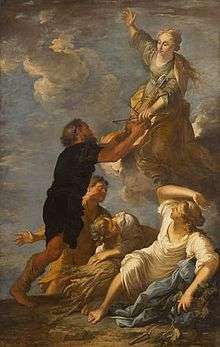 Astrea, c. 1665, the virgin goddess of Innocence and purity in Greek mythology
Astrea, c. 1665, the virgin goddess of Innocence and purity in Greek mythology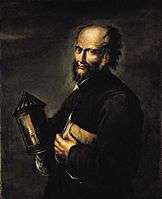 Diogenes searching for an honest man
Diogenes searching for an honest man Odysseus and Nausicaa, c. 1655 (Los Angeles County Museum of Art)
Odysseus and Nausicaa, c. 1655 (Los Angeles County Museum of Art) Port marina, 1640
Port marina, 1640 The Dream of Aeneas, 1660–1665 (Metropolitan Museum of Art)
The Dream of Aeneas, 1660–1665 (Metropolitan Museum of Art)
Works about Rosa

A number of biographies and fictionalizations of the life of Rosa exist:
- Domenico Passeri speaks of him in Vite de Pittori
- Salvini, Satire e Vita di Salvator Rosa
- Bernardo de' Dominici, Vita di Rosa (1742, Naples)
- In England, Lady Morgan in The Life and Times of Salvator Rosa, and Albert Cotton in A Company of Death romanticized his life.
- Rosa is the fictional hero of the novella Signor Formica, 1819, also known simply as Salvator Rosa, by E. T. A. Hoffmann.
- Salvator Rosa is a 19th-century Italian opera by Antônio Carlos Gomes, with libretto by Antonio Ghislanzoni, after the novel Masaniello by Eugène de Mirecourt.
- The 1846 ballet Catarina by the choreographer Jules Perrot and the composer Cesare Pugni was produced in London at Her Majesty's Theatre, and was inspired by the alleged story of Rosa's dealings with Brigands of the Abruzzi.
- One of the pieces included in the piano collection Années de pèlerinage by Franz Liszt is entitled "Canzonetta del Salvator Rosa". That song (Vado ben spesso cangiando loco) was, however, composed by Giovanni Bononcini.[11]
References
- Wittkower, p. 325
- Hobbes J.R. p. 241
-

- Langdon, Helen (2003). Rosa, Salvator. Grove Art Online.
- Elmes, James (1825). The Arts and Artists: Or Anecdotes & Relics, of the Schools of Painting, Sculpture & Architecture. London: John Knight & Henry Lacey. p. 91. OCLC 982205644.
- Storia della pittura in Perugia e delle arti by Angelo Lupattelli (1895), page 70.
- Lines from "The Indolent Castle", James Thompson, 1748 quoted by Helen Langdon in Burlington Magazine 115(84):p. 779 (1973)
- Johnson, Paul. Art: A New History, Weidenfeld & Nicolson, 2003, p. 339.
- "Archived copy". Archived from the original on September 23, 2015. Retrieved January 1, 2011.CS1 maint: archived copy as title (link)
- John Ruskin, Modern Painters Vol 1, part II, Chap 3, Also Modern Painters, edited and abridged by David Barry, Andrew Deutsch Ltd 1987, page 100.
- "Naxos Direct - Buy Performing Arts Media Online - Free US Delivery". naxosdirect.com. Archived from the original on September 28, 2013.

- Wittkower, Rudolf (1980). Art and Architecture in Italy, 1600–1750. Pelican History of Art (Penguin Books Ltd). pp. 325–7.
External links
| Wikimedia Commons has media related to Salvator Rosa. |
- 105 paintings by or after Salvator Rosa at the Art UK site
- Notes on etchings titled The genius of Salvator Rosa.
- Artcyclopedia entry on Salvator Rosa online.
- Exhibition 2011, Kimbell Art Museum, Fort Worth, Texas
- Free scores by Salvator Rosa at the International Music Score Library Project (IMSLP)
- Jusepe de Ribera, 1591-1652, a full text exhibition catalog from The Metropolitan Museum of Art, which includes material on Salvator Rosa (see index)